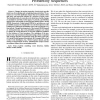1662 search results - page 270 / 333 » Mobiscopes for Human Spaces |
TIP
2008
14 years 9 months ago
2008
Changes in motion properties of trajectories provide useful cues for modeling and recognizing human activities. We associate an event with significant changes that are localized in...
TOG
2008
14 years 9 months ago
2008
Modeling the large space of possible human motions requires scalable techniques. Generalizing from example motions or example controllers is one way to provide the required scalab...
TOG
2002
14 years 9 months ago
2002
This paper presents an example-based method for calculating skeleton-driven body deformations. Our example data consists of range scans of a human body in a variety of poses. Usin...
RAS
2007
14 years 9 months ago
2007
In this paper we start from a set of images obtained by the robot that is moving around in an environment. We present a method to automatically group the images into groups that c...
ICRA
2010
IEEE
14 years 8 months ago
2010
IEEE
—We are concerned with enabling truly large scale autonomous navigation in typical human environments. To this end we describe the acquisition and modeling of large urban spaces ...

